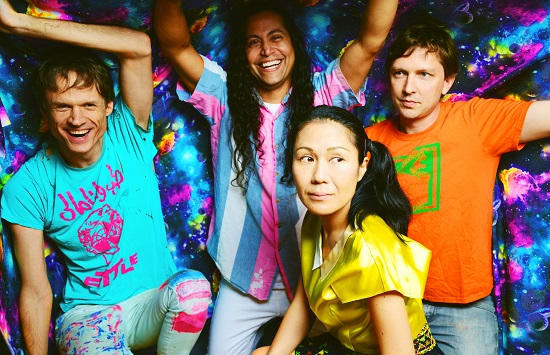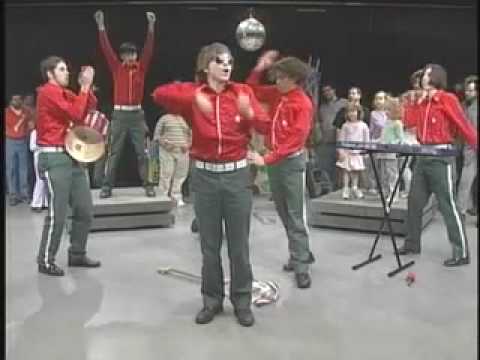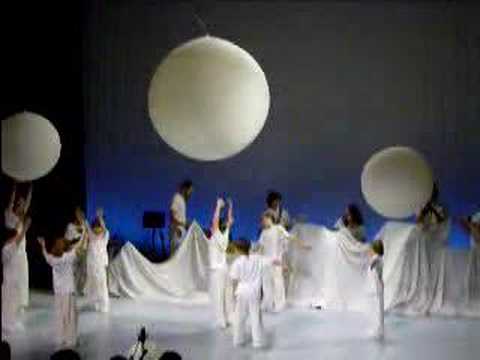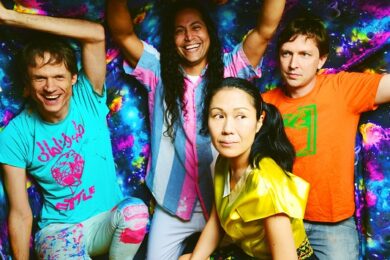In preparation for this feature, we asked Deerhoof to pick ten highlights from a career that now spans a quarter of a century. The choices Satomi Matsuzaki, Greg Saunier, Ed Rodríguez and John Dietrich sent back were as idiosyncratic as the band itself, taking in a bonkers school ballet set to their music, organised by a teacher on a remote island off the coast of Maine, to a series of onstage injuries and their friendship with renowned improv-noise loons XBXRX. Other than their excellent new album Future Teenage Cave Artists, below you’ll find no straight-up discussions of their old records. Instead our interview is a freewheeling ride full of joyous digressions.
Much of their choices are based around gigs, rather than records. From extraordinary outpourings of love from audiences in Buenos Aires and Manila to collaborative gigs like their shows with experimental percussion trio Tigue or the chaotic Congotronics vs. Rockers tour with Konono Nº1 and Kasai Allstars. “Because we always do home recording and it’s pretty DIY, albums seem to take months, in some cases years, it can be gruelling,” Saunier says. “I find the highlights are when we’re let out of the cage and can go on tour and have some fun. The songs come alive.”
With the four members based in different cities – we speak via a Skype call that spans four separate time zones – the vast majority of their new album was recorded even more fragmentarily than usual. Saunier would often send videos of himself playing the drums, around which his three bandmates would write individual songs. They’d find a way to stitch those pieces together, but rather than sand down the edges in search of coherence, they embraced jaggedness and inconsistency, juxtaposing different recording qualities for a record that is centred around its own brokenness.
Its character feels somewhat prescient, this was long before the coronavirus enforced this kind of recording on most musicians, and so too do its lyrics, which come from the imagined perspective of those “haunted by memories of a lost world and every failed attempt to save it.” For all its darkness and rawness there’s a tenderness to Future Teenage Cave Artists too, a sad kind of beauty that makes it among their best LPs to date. It ranks well among the picks they take us through below, presented in (rough) chronological order.

Meeting XBXRX, becoming friends and touring with them. 1997-present
XBXRX say they formed after watching one of your shows, is that true?
Satomi Matsuzaki: Yeah, in Biloxi, Mississippi, on Deerhoof’s first ever tour with Unwound.
Greg Saunier: The singer of XBRX, who now calls himself Vice Cooler, was 15 and he’d made the trip over from Mobile, Alabama. He was excited to see Unwound and he’d heard good things about the main support, a band called The PeeChees, but he’d never heard of Deerhoof who was playing first of three. The show took place at in a hall that had no stage, a linoleum floor with fluorescent lighting. It was like a bingo parlour or something. He showed up with no expectations, twiddling his thumbs and waiting for the bands to come on that he actually wanted to see. On that tour Satomi had made an orange plush bear costume that she performed inside of.
SM: It was incredibly hot.
GS: That very day we’d stopped at a gas station in Louisiana where they sold lizard hands…
SM: It was an alligator’s hand, a back scratcher.
GS: Yeah! So Satomi had bought an alligator’s hand with what little remained of our takings from the tour, and decided to debut it at the show in Biloxi, running into the audience and tapping people on the head with it and shouting something in Italian, ‘da capo!’, which I think means when you go back to the beginning of the piece but literally means ‘to the head’. Vice Cooler got hit in the head by Satomi during this performance and was so into it that after we were done, he immediately came to the merch table and bought everything we had. The next day we played Pensacola on that tour and Vice Cooler said to his brother, who was 14 and had a fever, ‘you’ve got to come see this band!’ The two of them formed XBXRX very shortly thereafter. Then they got tired of Mobile and moved to where Deerhoof lived.
John Dietrich: I think our first US tour after I joined was with them. We took turns opening for each other. Then Ed moved to the Bay Area too, he joined XBXRX before he joined Deerhoof.
Ed Rodríguez: They were completely insane. We played in Japan at a venue that had a balcony, and on the first note the guitarist Steve ran out screaming and tossed his guitar into the balcony. It was the most anti-climactic thing, because it was this huge gesture then we immediately had to stop while he climbed up the wall to get it back. I’d look up from playing bass and they’d have blood dripping down their heads. Vice is a producer now, he works with Peaches and all those people.
JD: He did our video with Michael Shannon too [for 2014 single ‘Exit Only’].
Milk Man, the ballet, 2006
When I read into the story of this, it blew my mind. Can you tell us exactly what happened?
GS: A woman called Courtney Naliboff wrote us an email. When Milkman came out in 2004 she was at college in Boston. She was a total stranger but was like ‘Hey! Great job, I really like the record, I could imagine it being a ballet some day!’. We were like ‘Ha! Thanks for writing!’. Years later, she’d moved to a tiny, remote island off the coast of Maine, population 200 or something. It had a one-room schoolhouse where she was the English teacher, the music teacher, and the choir teacher. The gym teacher was the ballet teacher. She wrote back to us saying ‘remember me from five years ago? We’re going to do the ballet with the schoolchildren!’ I said, ‘Do you need any help arranging the songs?’ and she said ‘No! Me and my husband figured it all out!’
So the production was entirely independent of yourselves?
GS: Our participation in all of this was just to show up and see the final dress rehearsal. We got there and it was complete, it was totally done. They’d arranged every note of the record for banjo, guitar, a guy playing drums on a bunch of cardboard boxes, a kid from middle school on the alto saxophone, the pastor of the church was playing clarinet, the pastor from the church on the next island was playing a trumpet and that was it. It was a one room schoolhouse, so 1st grade to 12th grade was represented in the dancing and the singing. They had this incredibly imaginative avant garde dance choreography worked out that involved strings and ping pong balls coming down from the side of the stage. It was a once in a lifetime thing, the highlight to beat all highlights. The amount of love that went into it was shocking.
JD: There was this sense that the whole island had come to see the show.
How did it go down with the islanders?
GS: It’s a cliché that big cities with all the hipsters are the ones that can ‘handle’ these experimental art forms and the backwater towns that can’t. There’s so many instances in our lives of the exact opposite. The entire island came out, from crying babies to grandparents. There was no reason to be like ‘Oh, Deerhoof. I can’t stand that band.’ They weren’t reading The Quietus every day to learn what it is they’re supposed to like. It was pure human interaction with no fixed ideas or preconceived notions and so the reaction was completely pure. A few weeks later we got a message from Courtney saying most of the kids on the island dressed up as Satomi for Halloween.
I saw this brilliant quote from Courtney around the time: “When you listen to Deerhoof’s music and you teach an elementary music class you hear a lot of the same things, you hear a lot of really creative imagery, a lot of non-sequiturs, and you hear a lot of sounds being made in ways you didn’t think they could be made.” What do you make of that?
GS: Courtney’s a genius, she’s got the energy and ambition of ten people packed into one person. That statement is very beautiful, but I think it says more about Courtney than it does about us! We went back to visit a few years later actually, Deerhoof played a show on the island. Courtney had taken on even more responsibilities and the school was moving to a bigger building that she was partly overseeing the construction of. She had also started the only bakery on the island. And she’d just had a baby. More power to her, I like the idea very much that if someone has energy that they shouldn’t try to tone it down.
Touring with Radiohead, 2006

Johnny Greenwood, Satmomi Matsuzaki and Thom Yorke. Photo courtesy of Greg Saunier
GS: One day in Ireland we had a day off, so we booked our own club show. We went out to dinner before the show and we could only find one vegetarian restaurant. We walk in and who’s sitting at the table but Thom Yorke, Johnny Greenwood and one of their tour managers, this guy Brian. It turns out Brian had roped Johnny into playing some Irish music gig that night which he didn’t want to do, and then Jonny had roped Thom into coming along, which Thom didn’t want to do. We said ‘We’re playing down the street’ and Johnny rolls his eyes and Brian rolls his eyes, then Thom gets this funny look in his eyes…
JD: The gig wasn’t particularly well attended, even for a small venue. There was a corner where nobody was really there apart from one guy, and we looked over and it’s Thom Yorke, completely freaking out.
GS: We stuck out like a sore thumb on that tour, they had a travelling city and we turned up to the very first show in a Prius. The people at the parking lot gate wouldn’t let us in at first, they thought we were just trying to get autographs. But from the instant we got there they made us feel welcome. Ed O’Brien kept coming over and asking John how he got his sound, Johnny would come at the end of the show and bring us some really expensive champagne.
And he once secretly did your light show?
GS: It may yet have been still be the best light show we’ve ever had! He was so familiar with every single thing that we were doing, he could anticipate every surprise, we could stop for a second and we’d come charging in with the strobes. One day I asked them why they’d gone to so much trouble to make us feel so welcome in their world, and it was Thom who told me ‘well, R.E.M took us on tour once and that’s how they treated us’.
Is it something you’ve passed along to the bands who’ve supported you?
GS: I’ve not personally brought champagne
SM: They can share our carrots.
Meeting David Bowie who picked Deerhoof for his Highline Festival in New York, 2007
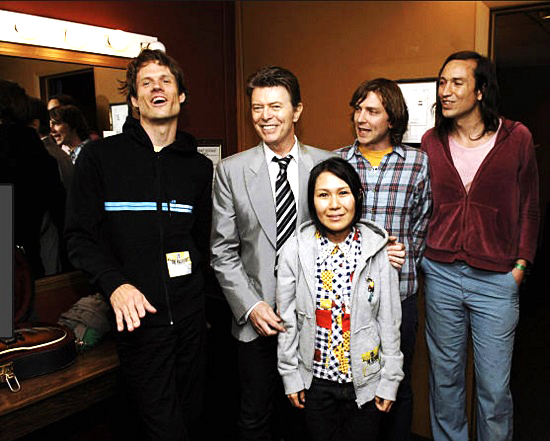
Deerhoof and David Bowie. Photo courtesy of Greg Saunier
Did you know he was a fan?
GS: He had been coming to our concerts a little bit, but we’d never met him or spotted him. People would just say things like ‘did you see David Bowie was here?!’ He had been asked to curate this festival in New York and it was maybe half an hour before we were meant to go on that this message came through: ‘Go backstage, he’s going to show up!’ We’ve met celebrities and famous people before and since, but there was something particularly special about this particular experience. First of all because he walked in in a three-piece suit, necktie, his hair absolutely perfect…
SM: And super strong perfume!
GS: He shook us all by hand and knew each of our names, he’d obviously prepared. He’d just come from another highline concert at a different venue, ‘The Music of Conlon Nancarrow’.
I’m not aware of him…
GS: He was an American composer from the mid-20th Century who was exiled to Mexico and had nobody to perform his music to because he was out in the boonies somewhere. He started writing all this music for player piano but because he could just punch stuff out on a piece of paper and do seven notes in the space of 15 they were ridiculous computations that no human being could ever play. David Bowie had just come from a concert where someone had made chamber music arrangements of Conlon Nancarrow’s Music For Player Piano that humans had actually mastered.
What were your conversations with Bowie like?
GS: His mind was completely blown by this Nancarrow concert, he was talking with such obvious, genuine, and excited enthusiasm, and also pride that he had been the one to book it. Then he had Ken Nordine, the Word Jazz guy coming in in a couple days and he couldn’t wait for that show. You realise ‘this guy’s an actual music fan, he’s not just doing it for show, this actually means something to him.’ That’s why at least to me that was a big highlight, it wasn’t just the meeting of a famous person, it was the meeting of a real role model for whom the devotion of one’s life to music was a real passion, nothing had corrupted it.
SM: He had a very innocent energy, he just kept talking music, music, music.
Playing with Marlene Marder of LiLiPUT and Kleenex in Switzerland, 2010
Did she literally just show up out of the blue?
GS: We had been doing a cover of one of their songs, ‘Hitchhiker’, and we just loved the song. When we were talking to the promoter of a show in Switzerland and he said ‘Marlene, the guitar player from that band, she still lives around here, maybe I can get her to come to the show!’
JD: She hadn’t been playing music for a long time.
From what I can make out she had been travelling around the world on a boat until that point, working for the WWF…
JD: She was very nervous about [playing the song live with Deerhoof], but when she got up there and started playing it was just… I couldn’t believe that there had been any hesitation. She was incredible!
Is it true that she pointed out you had the words wrong?
GS: We were just doing it by ear!
Did you stay friends afterwards?
SM: She lived in Geneva, so the second time we played here she came onstage again. We became good friends. It was nice!
JD: The fact that it didn’t seem like there had been anything in the past that had drawn her back into playing music made it feel really, really special. To see that excitement in her, that spark, to look at somebody and see such genuine happiness when she was playing… It wasn’t like this person hops on stage any time a band comes to their town. It was very special feeling.
The Congotronics vs. Rockers tour, 2011

The cast of Congotronics vs. Rockers. Photo courtesy of Ed Rodríguez
GS: How much time have you got?!
I get the sense this tour was pretty chaotic, what are your abiding memories?
JD: It was the most insane tour possible.
ER: Nobody spoke the same language and there were 20 people in the band.
GS: The seven people from the Congo all spoke different languages to each other!
ER: Trying to find a workable way of doing things together, that was really difficult, but once we started playing it was so interesting. The musicians from the Congo’s relationship towards what they were doing was in a different realm to what we were doing. We were doing shows that were an hour long, they were used to playing for 12 hours. They’d get hired to do a wedding or a gathering and they’d play until the sun comes up. It was such high energy, the second the show started on stage there was so much joy coming from everyone. It was such an intense feeling of being on this train, just trying to hang on. Every time we’d got to the end they’d be looking around like ‘but we haven’t even started yet!’
Before the shows you’d contributed to an album, Trad-Mods vs. Rockers, covering a Kasai Allstars Song. How did that develop into that live tour?
GS: Crammed Discs that puts out the Congotronics series had been releasing Konono Nº1 and Kasai Allstars and we’d all been fans, and they asked us if we’d do a remix or a cover or a ‘song inspired by’, so we said we’d do a cover. We were in the middle of recording Deerhoof Vs. Evil in a practise space in Oakland, then one day we sat down and thought ‘we’ve got to figure out how we’re gonna play this song.’ It was so hard, I was really struggling to do some impression of the rhythm, trying to figure out my limb coordination. Boy did I feel like hot stuff once I had it down. The original was called ‘WA Muluendu’, but the English is ‘Travel Broadens The Mind’. We were so hot on that thing!
Marc Hollander from Crammed Discs a couple of months later said ‘that cover was so amazing, would you up for doing a supergroup with Konono Nº1 and Kasai Allstars? We’ve got you, Juana Molina, this Swedish group called Wildbirds & Peacedrums, we’ll get them all on stage at the same time, we think it’ll be really amazing!
What was the first rehearsal like?
GS: We show up, day one, in Brussels. The stage is filled with equipment. Everybody’s looking around, not knowing who’s in charge because nobody’s in charge and we’re like ‘should we do it?’ and we start playing ‘WA Muluendu’. We were thinking we’re the hottest shit anybody’s ever seen, but the Kasai Allstars just stood there with their faces turned to stone. They couldn’t even tell what we were playing. We were like ‘It’s ‘WA Muluendu’!’ so then they start playing and our faces turn to stone. We didn’t recognise one note, it sounded like they were playing ‘Hot Hot Hot’, that calypso hit from the ‘80s. We realised we had completely misunderstood what key the song was in, and we’d imagined a series of minor chords. It was meant to be simple, just three major chords. We’d also literally placed beat one in the wrong place, our beat one was on their beat two-and-a-half. We had to give up on doing that song within five minutes of the first rehearsal. I remember Marc Hollander’s face, the crushing disappointment that his pièce de résistance, the whole reason the supergroup was formed, had been scrapped within minutes.
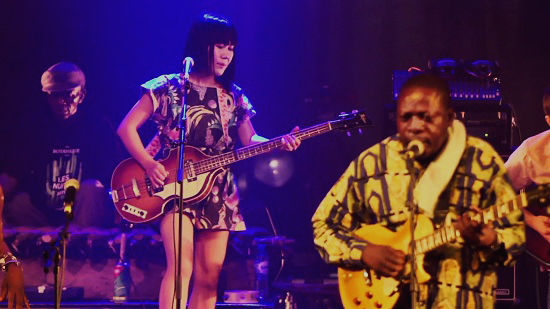
Photo courtesy of Greg Saunier
But I’ve seen the footage of the shows, and they look great…
GS: Incredible, but very trying.
JD: Deprogramming our brains for what we thought we understood was the hardest part. It’s like you’ve heard ‘Louie Louie’ your whole life, but then someone tells you ‘the one is on the second Louie’. Vincent, who was playing bass in The Kasai Allstars, explained that they have these patterns that exist in 95% of their music, but then there’s 5% that’s different.
What happens then?
JD: We never got to the bottom of that. That was kind of the best part of it, the total inability to agree on this one thing, and the necessity to continue to be creative together.
GS: We thought that we were weathered touring musicians or whatever, but on this tour people had malaria, people went into diabetic comas and had to be replaced mid-tour, an instrument that was built from a specific tree in Africa got a crack and was irreplaceable unless they could chop down a new tree and make a new one. People were having breakdowns daily.
SM: So many breakdowns! At one point there was a fight between Kasai Allstars and Konono, I think it was about a woman…
“Ed lost his contact lens in the back of his eye during a show, then his guitar broke and he couldn’t find his glasses nearby. John and Greg kept going while Ed panicked”. Plus other injuries.
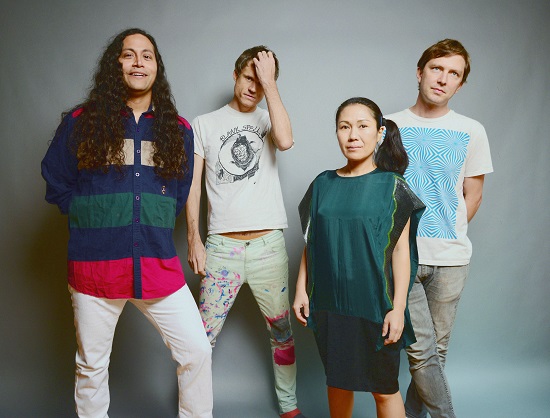
ER: I’m completely blind without them. I feel like it keeps happening…
SM: We’d only had a quick soundcheck, so some circuit was broken. During the show Ed started checking his pedals but I could see something was wrong. It was a small venue, so everyone was just really close, looking at us. Greg was playing so wildly and John was just rolling his eyes so I thought ‘OK, I need to figure this out quickly’. I found Ed’s glasses and then it turned out that guitar wasn’t ringing properly.
GS: The search for the glasses was just so he could figure out what’s wrong with his guitar tone?!
SM: For like eight minutes.
Didn’t you once break your back on tour, Ed?
ER: Somebody hit us on tour. We were on our way to the show and my stomach started to distend a little. They dropped me off at an emergency room and did a couple of CT scans and X-Rays and found out I had a couple of fractured vertebrae.
GS: Meanwhile, the opening bands have started playing, one family had come and brought us a Deerhoof cake, there was an intense build up!
ER: I flew back home the next day and I had to see a back specialist immediately, but they said I couldn’t see a specialist without a referral from a doctor even though I’d been to the emergency room. Eventually I did get the OK to see a back specialist but the first appointment open was eight weeks later. I didn’t know what to do so I just wore a back brace and played sitting down for the whole tour. When the tour was finished everything had already healed, I told them what used to hurt, and they said it was fine.
Is it always Ed that suffers the worst injuries in the band?
SM: On the last tour it was John sitting in the chair on stage.
JD: I broke my toe playing soccer.
ER: We have to cover for each other a lot, like when John fell off the back of the stage and none of us even noticed because he kept playing.
SM: The guitar was flawless!
Any others you’d like to recall?
SM: I once got my fingers smashed in France.
ER: And you fell off the front of the stage that time in Italy.
SM: I didn’t want to play this Ramones cover we were doing on that tour so I asked Ed to play my bass part. I just took a break during that song and went back to do laundry.
ER: Satomi is obsessed with doing laundry on tour. The venue had a washing machine so she threw her clothes in before the show stared, then when we got to that song all of a sudden she disappears to run upstairs and throw her clothes from the washer to the drier.
The band’s first shows in Buenos Aires and Manila, 2017
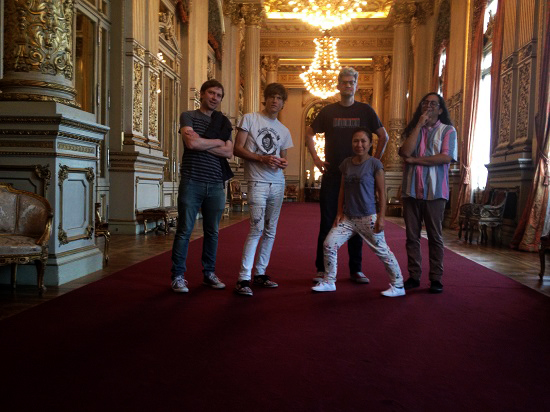
Deerhoof in Buenos Aires. Photo courtesy of Ed Rodríguez
JD: A good friend of ours works at the big opera house in Buenos Aires, and they have a cavern in the basement that had been sitting there unused for a long time. He had been asked to curate a series in that space, so we got to be the first ever rock band to play the opera house. Before we played we got to wander around and grab huge, bizarre props from the opera. We had a bird cage that was nine feet tall that we put right in front of Greg for people to sit in for one song.
ER: Since they’d never had a show there before they had no idea how many people to let in so it was shoulder-to-shoulder packed with all these people singing together, way louder than we were.
SM: One of you broke a string and as soon as you stopped playing they start singing ‘Olé! Olé, Olé, Olé!’
GS: As soon as we started playing the first song in Buenos Aires, and it was exactly the same when we got to Manila, the entire audience in unison was singing every section of every song, including the bass parts and the guitar parts, they were air drumming the vocal parts, they were so familiar with every detail. I don’t even know how to describe that experience. It’s totally surreal, that something that started out as totally imaginary, private songwriting experience for any one of the four of us ends up being something that total strangers on the other side of the globe had gotten to know so well. It’s shocking and so touching.
JD: When you’re out on the street in an unfamiliar place it’s overwhelming, but then as soon as you get into a room with people to play music it’s amazing how quickly you start thinking ‘if I lived in this city, these would be my friends.’
GS: The show is the permission slip for everybody to be friends, the excuse to strike up a conversation with total strangers. I feel like I’ve seen so much and learned so much about the way it is outside of my country, what things are different and what things are exactly the same. People everywhere like to smile and dance and have fun.
Performing Friend Opportunity in full with Tigue at the Ecstatic Music Festival, 2019
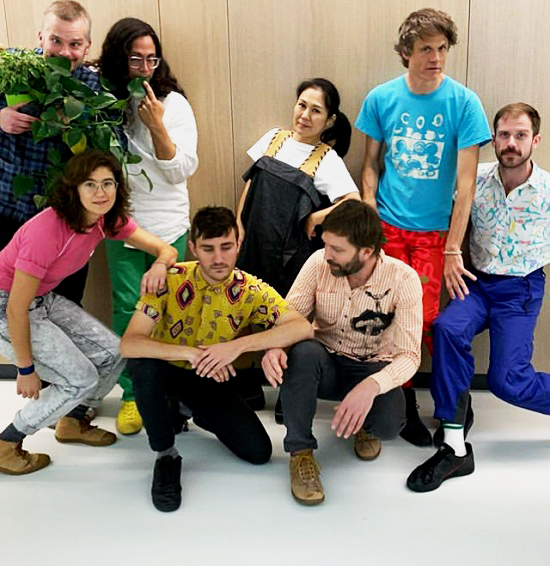
Deerhoof and Tigue. Photo courtesy of Ed Rodríguez
Did you have any reservations about playing old material?
GS: Yeah, because at first we didn’t think it would be very interesting, but we also didn’t think it would be possible. In 2007 when that album was new we’d end up dropping a lot of those songs from our setlist because it was like, ‘we can’t pull this off live’. It was before Ed joined the band, so John was trying to cover two guitars and one keyboard part all at once. We kind of gave up on the idea of being able to play it live. But then we saw Tigue perform as the opening band at this show in New York and thought ‘this is incredible, they can play anything. So between them finishing their set and us loading our gear onstage we hatched a plan of ‘let’s do Friend Opportunity, that song has a lot of drums on it.’
SM: By the way, Tigue are a percussion trio.
GS: We gave them a homework assignment. ‘Hey Tigue, learn our drum parts, then I’ll play piano, or keyboard or something.’ It was a miracle.
Friend Opportunity seems to be your most enduringly popular album, why do you think that is?
GS: I actually don’t think that’s true. I’ve typed Deerhoof into iTunes before and songs from that are the ones that come up towards the top, but whatever the mathematical computations and the artificial intelligence gremlins are inside some server in Cupertino, California or Sweden, those decisions are based on sales data. Friend Opportunity is the one that sold the most copies, and the reason it sold the most copies was because, ironically, it was before the era of the takeover of streaming. When we’re working the merch table like we do every night on tour there’s not a single album on the table that isn’t somebody’s favourite. I could try and speculate about whether it’s ‘more chill’, so that’s why it does better on a chill-rewarding platform, but the fact is when we played it as a complete album with Tigue, with seven of us on stage, it’s not really that chill. It’s as ill-suited to chill playlists as any of our other records.
Future Teenage Cave Artists, 2020
There’s a quote in your press release that this album is about ‘people haunted by memories of a lost world and every failed attempt to save it’. That’s quite prescient…
GS: It’s a little strange because since we started living in four different cities, we’ve been doing a lot of home recording as a band, everybody emailing stuff to each other. It’s kind of a weird coincidence!
Tell me more about how that theme came together…
GS: We’d been building up a huge pile of rough demo instrumental tracks, but then themes started to come together very quickly from the fragments and we realised that these demos aren’t demos any more, they’re the record. Satomi had a few scattered phrases of lyrics here and there; it was like a strange archaeological dig where we had to go back and unearth the fragments and piece together a larger image or narrative. There was a prehistoric vibe to it where things that were made as demos intended to spark something fun in the future ended up being etched in stone. Everything’s really rough, the sound quality’s constantly varying and there’s no telling who’s playing what instrument. It was all done remotely in fragments by members of the band in their own homes.
Can you take me through the specifics of the remote recording process?
GS: An example would be like, I recorded the drumbeats on Photobooth with the inbuilt mic on my laptop because I couldn’t think of another way to quickly record anything. So Ed, John and Satomi would each make up totally different song ideas, going with the same drumbeat, then we would find a way to combine all the different unrelated songs.
SM: It was so strange when I opened the email and was just videos of you playing the drums, like 20 of them.
JD: We should release those at some point.
GS: The fidelity varies wildly between being super distorted and sometimes being recorded really nicely. John recorded his stuff carefully and it sounds really clear, a lot of the worst sounding sounds come from me.
JD: You should talk about Satomi’s art, too, talk about prescient!
Satomi, tell me about the artwork!
SM: I started drawing the album cover around Christmas time, right before I went to Japan to see my parents for new year. We were talking about presenting some apocalypse that was about to happen because of the destruction humans are causing, the problems with politics, religions, the harms of high technology, all that stuff. I started drawing tornadoes and a dried up lake, and I drew a virus. Then I went back to Japan and this Wuhan news came out. It didn’t say coronavirus at the time, but we already had a subconscious knowledge that somewhere it was coming. And now it’s come, and this album has come out at this time. It’s really, really heavy to me!
GS: A lot of the increase in natural disasters, famine, desertification, climate change, disease, war, the possible harms of certain kinds of technology, it’s not like no one was ever warning us. After we finished the artwork one of the venues we were supposed to be playing in June was destroyed by a tornado. I think we were trying to make a record about ‘what it might feel like’, what it’s going to be like in a few years’ time if you’ve managed to survive. It might not be like Mad Max, it might not be exciting, it might be boring, or frustrating or you might be haunted by weird memories or you might feel guilt for having survived, or you might feel guilty you never tried hard enough to save things. Would your dreams change now that you’re fighting for survival, you’re tring to find food or water and wild animals are starting to take over again like they are in all those videos?
A lot of the music represents this brokenness, using left over technology with the sun way too hot beating down on you and you’re thirsty, and everything feels a little scrawny and hungry. You’re trying to piece togetherr communities but everything’s makeshift and never really catches on.
How do you think it measures up against all the career highlights we’ve been talking about thus far?
GS: I think it is a highlight! I think it’s touching, but I also think it was a little bit of a dark place to be, not just in terms of themes but the process of making it, this remoteness from each other is a way to make things that does produce a result but it’s not always the funnest way to do it; I think we all missed being together. We only did one song when we were all actually together to record it, ‘Zazeet’, and that one was the most fun in that sense.
And what does the immediate future hold?
GS: The next things Deerhoof will put out will be returning more to the sound of us playing together. We have a live thing that’s just about finished, and then something we recorded live in the studio, kind of going for a completely. In the middle of the period the music industry was glutted with touring bands we decided to do this remote quarantine record, and now that it’s quarantined, now we want to put out an album of what we sound like when we’re playing live. Our timing’s off!
Deerhoof’s new album Future Teenage Cave Artists is out now via Joyful Noise. You can buy it here

